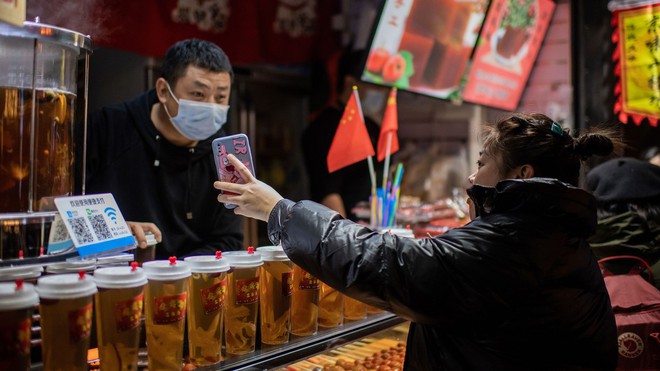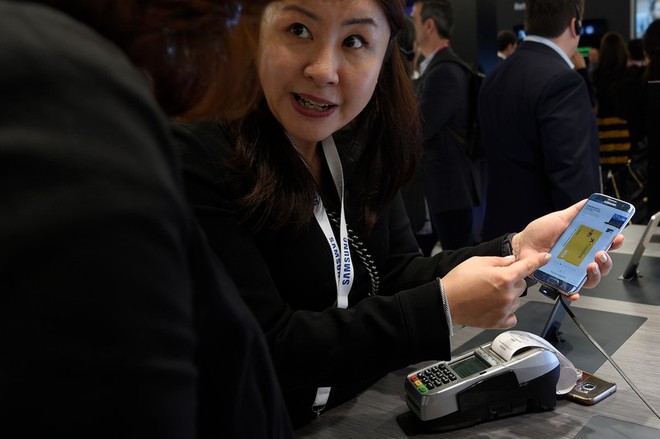What is it like to live in a cashless society?
- Tram Ho
More than a decade ago, Alipay launched in China, promising online transactions that will be easy for everyone. A few years later, the Chinese super app WeChat introduced a similar mobile payments service called WeChat Pay to its millions of users. Today, these two platforms are pervasive on every smartphone in the country, spurring a mobile-based revolution to make China one of the largest cashless countries in the world. gender.
Home to about 1.4 billion people, hundreds of millions of users here have used smartphones to pay for everything. Most small businesses have a QR code that allows customers to scan with payment apps to make purchases. This has become so common that the government has to crack down on merchants who refuse to pay cash from customers, insisting that the yuan remains the legal currency in China.

Toby Graham, 40 years old, based in Shanghai, works for an international accounting firm. For him, the return to cash is unthinkable. “I can’t tell you when the last days I use cash here, but it’s definitely been years,” Graham said. He has lived in China for 8 years and has followed the development of WeChat and Alipay nationwide. By 2017, he also stopped using ATMs.
“In the past four months, because of work, I have traveled to seven major cities in China and all I brought with me was my passport, some clothes and a phone,” said Graham. “I don’t need to cash out. I don’t even have a wallet.”
Graham explained that although he also has his credit card, he will only use it in case he loses his phone.
“The phone is the way you do everything. I use it to pay utility bills and bills, pay rent to the landlord, shop online, buy groceries at the supermarket. I can’t think of a thing. I can’t do it with my phone here, ” he said.
The use of mobile payment apps has even infiltrated remote villages. According to Chinese market research firm Daxue Consulting, nearly half of the country’s rural population uses mobile payments regularly. In 2017, transactions through non-bank mobile payment services in rural areas totaled $ 6.64 trillion.
“I’ve seen small businesses – I’m talking about the street fruit shops, or guys making fried noodles and pushing their cart down the street – and they don’t even accept cash,” Graham said. to speak. “I also always see beggars and they’ll carry a QR code that you can scan to give them money.”

Alipay QR code (blue) and WeChat QR code (green) at a street grocer in Beijing.
On a more remote continent, Sweden, a similar situation is occurring. This Nordic country is predicted to be completely cashless by 2023, operating only with digital payments and cards. Many local businesses such as bars and restaurants, even banks, have stopped handling cash. According to the Swedish central bank, the percentage of Swedes using cash between 2010 and 2020 has fallen from 40% to less than 10%.
Valter Primus, 20, now thinks it’s strange to see people use cash. “I don’t really see anyone do that. Now I see it mostly in movies , “ he said.
The college student says the last time he paid for something in cash was when he was 13, just before he got his first debit card.
“I don’t remember exactly what it was for. Probably buying a school sandwich or something,” Primus said. “Then I started using Swish. It’s an app that lets you transfer money from your account to someone else using their phone number.”
Swish was launched in 2012 by Sweden’s six largest banks and has since attracted more than 7 million users nationwide, making up more than two-thirds of the country’s population. With Swish, Primus no longer has cash with him or at home, which he says is normal.
“To be honest, I can’t imagine going back to cash. It seems pretty complicated and 19th-century,” Primus said. “Even my great-grandparents tried to learn how to use Swish and not use cash anymore.”

A woman is showcasing the Samsung Pay system at an event in Barcelona.
Back in Asia, South Korea is catching up to China when it comes to cashless payments. It is one of the countries with the most Internet users in the world, and in 2018 cash was only 20% of all payments.
A 20-year-old Korean college student, who wants to be known as J, said she only used the cash last month to buy birth control pills in the morning. But for everything else she buys in everyday life, she uses a personal phone.
“I think the younger generation – I mean people under 65 – are definitely more inclined to digital payments,” says J. “If it’s not a credit or debit card, people use apps to transfer cash like KakaoPay, Samsung Pay and ZeroPay.”
In Singapore and neighboring Malaysia, people are also increasingly turning to mobile payments, but many people still use cash in small establishments or rural areas that are not equipped with technical payment systems. number.
“Cash is for places I know they won’t use payWave, a contactless payment method. So like a food market or a hawker center,” said Nica Rollan, 28, a Filipino. say work in Singapore.
Hesper Buckland, 19, said the situation is similar in Malaysia.
“I usually have a little cash on hand every day because [in Malaysia] we have some street vendors or local food places owned by the elderly and they only take the cash. For everything else, I use a payment app on my phone, “ he said.
The street vendor center is an outdoor food court with stalls selling local delicacies. Until recently, these stalls usually only paid for with cash, but the local government has been working to digitize these businesses.
While Rollan appreciated the convenience of not having to carry coins and bills at all times in Singapore, she said that if she went back to the Philippines, she would probably go back to using the cash as usual.
“Financial services are fragmented [in the Philippines], unlike in Singapore where everyone uses electronic services like PayNow and PayLah,” she said. “No cash [in the Philippines] will only increase the income disparity. Digital and cognitive education is not there, let alone basic education.”
While many are optimistic about the idea of a cashless society, there are others, like Rollan, worried that it will leave some communities behind. San Francisco-based consumer finance expert Erica Sandberg shares the same concern.
“Moving to a completely cashless society has no small consequences. Not everyone has a credit card, debit card or smartphone with a mobile wallet,” Sandberg said. shall.
“A physical wallet where you store your bills and then pay for everything when you use it is a powerful process. It’s tangible,” she added. “You can see your money disappear as you spend it, so you’re more likely to be more careful.”
Sandberg also warns that going completely out of cash can affect personal freedom and privacy. “Being able to make an untracked purchase is important. Cash provides the ability to execute transactions that cannot be supervised by marketers and other companies,” she said.
But privacy concerns don’t always result in users limiting the use of the technology, especially during a pandemic, when contactless transactions take precedence. Richard Hartung, chief executive of Singapore-based financial consulting firm Transcart, said cashless transactions in Asia are on the rise, despite privacy issues for most. Convenience is a priority for everyone.
“Digital payments have grown due to the growing number of options, lower costs of digital payments, and more recently because the epidemic has accelerated the digitization process,” Hartung said.
He also said that although China is ahead of the movement in Asia, it is only a matter of time before other countries don’t use cash.
“Other parts of Asia will catch up. Convenience will help. Government will help. Innovation has its benefits. But COVID pandemic digitization is the driving force behind.” the biggest, “ he said.
Refer to VICE
Source : Genk
